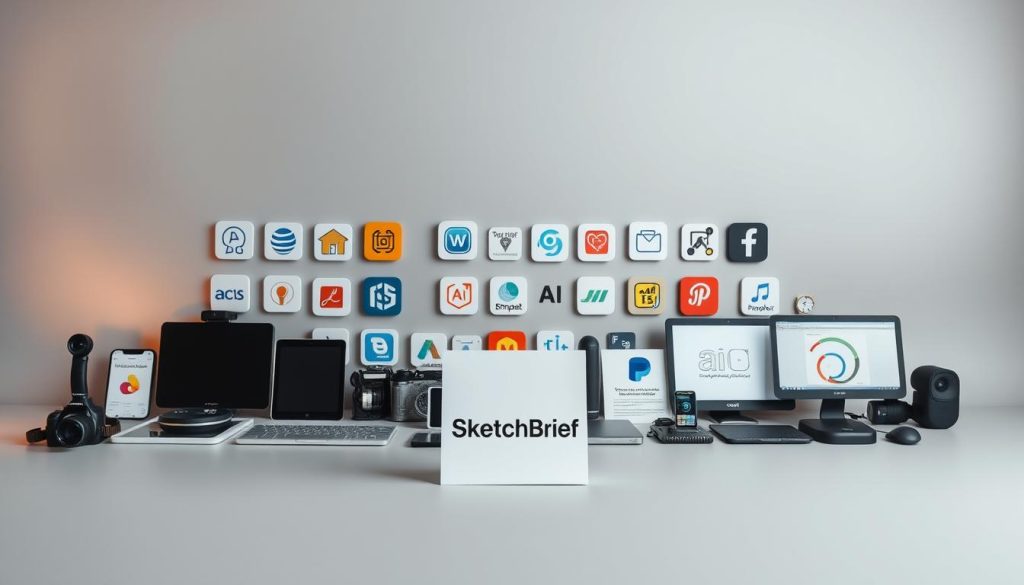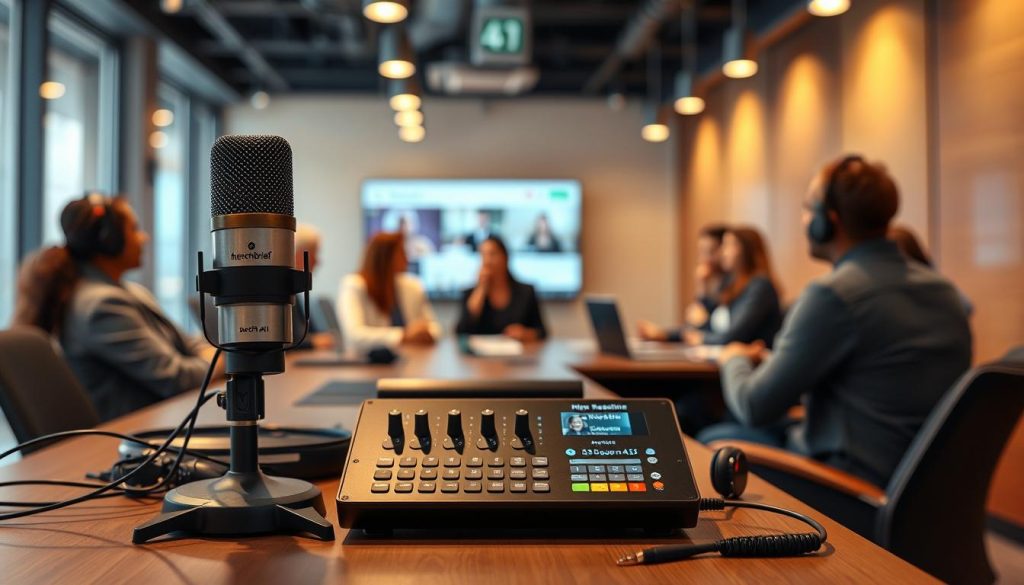Can a single tool really capture every idea in a fast-moving meeting without pulling you away from the conversation?
We know teams struggle to hold ideas and action items during long sessions. Capturing clear meeting notes and precise summaries saves time and reduces rework.
We’ll show which tools fit real workshop scenarios—from silent, on-device recorders to full meeting assistants that join video calls and save files to your preferred platforms.
Expect practical guidance on audio and video capture, supported file types, language coverage, searchable content, and how data and privacy are handled.
By the end, you’ll have a clear path to pick a solution that preserves the participant experience, converts conversations into usable content, and protects your data.
Key Takeaways
- We help you choose tools that match your privacy and platform needs.
- Look for features that generate action items, highlights, and summaries.
- Check language support and accent handling for global teams.
- Validate audio/video capture, file uploads, and Zoom/Meet integration.
- Understand data retention, deletion policies, and where transcripts live.
Search intent and who this roundup is for
Fast, idea-rich meetings often leave gaps in what got decided and who owns next steps. This roundup helps you pick between lightweight on-device capture and full meeting assistants so your team keeps focus while gaining reliable meeting notes and insights.
When you need lightweight capture vs full meeting assistants
Lightweight capture (on-device, background)
Use on-device tools like Jamie when you want unobtrusive audio capture. These options avoid a visible bot in the room and suit brainstorming and creative sessions where manual note-taking would interrupt flow.
Full meeting assistants (bots that join and act)
Bot-based services—Otter, Fireflies, and Tactiq—auto-join and offer live transcripts, highlights, and action items. Evernote AI Transcribe ingests recorded files or browser audio and organizes outputs with tags, highlights, and checklists for later review.
- Brainstorming sessions: prefer bot-free capture to keep conversation natural.
- Training and enablement: choose structured summaries and clear steps.
- Cross-functional planning: pick tools that tag keywords and speakers for traceability across meetings and Google Meet.
How to choose tools for workshop notes AI transcription
A solid capture strategy makes sure no key decision gets lost after a session.
Audio quality and background noise handling
Prioritize capture quality. Choose tools that separate voices and reduce background noise in real rooms.
Examples: Krisp offers bi-directional noise cancellation. Jamie records on-device to keep source audio private and clear.
Multilingual support for global teams
Validate languages and accent handling. Evernote AI Transcribe and Superpowered support 50+ languages for broader coverage.
For mixed-language teams, pick platforms that maintain accuracy across speakers.
Action items, summaries, and outputs
Look for features that auto-generate action items and editable summaries. Those outputs should map to your organization tools—docs, PM systems, and CRM.
Privacy, data retention, and compliance
“Confirm whether providers train on your data and how long recordings persist.”
Evernote keeps content out of model training and offers third-party deletion within 30 days. Jamie deletes source audio after transcripts and follows GDPR practices.
Compatibility with Zoom, Google Meet, and Microsoft Teams
Ensure integrations with Zoom, Google Meet, Teams, or Chrome-based capture. Tactiq integrates via Chrome and supports Meet, Zoom, and Teams—useful for hybrid setups.
- Prioritize capture quality and fallback uploads.
- Validate languages for equitable participation.
- Confirm export paths so action items flow into your workflow.
Bottom line: Match features to real meeting needs—clarity in audio, reliable outputs, and strict privacy—so your team spends less time reconstructing decisions and more time doing the work.
Top products at a glance
We’ve grouped top picks so your team can compare features at a glance.
Bot-free options run quietly in the background to preserve a natural participant experience. Jamie records on-device, follows GDPR, offers a free tier, and deletes source audio after transcripts. Superpowered supports 50+ languages and holds SOC 2 Type II compliance. Krisp focuses on noise cancellation without auto-joining bots.
Bot-based apps join meetings as visible attendees and often deliver richer live features. Otter auto-joins and provides live text in English, Spanish, and French. Fireflies joins calls and lets you search across meetings with smart filters. Tactiq works as a Chrome extension for Meet, Zoom, and Teams and saves transcripts to Google Drive.

Free plan availability and limitations
Most vendors offer free plans, but expect limits on minutes, storage, or advanced summaries.
- Trade-offs: free tiers help you validate quality but often limit export formats and minutes.
- Speed vs control: choose instant summaries for fast follow-up, or upload-based workflows when you want review before sharing.
- Cost factors: include add-on AI credits and storage when budgeting for team use across platforms.
“Start with a free plan to validate quality, then scale when your team confirms clear outcomes.”
Evernote AI Transcribe: flexible files, 50+ languages, and deep organization
When sessions produce audio, photos, and video, Evernote centralizes everything into actionable content.
What stands out for workshops
File support is broad: upload MP3, WAV, AAC and MP4, AVI, MOV. You can also add JPG, PNG, GIF, and PDF for images and scanned agendas.
Live browser tab recording captures audio without waiting for exports. Links from YouTube, Instagram, Facebook, TikTok, and SoundCloud also transcribe directly.
Collaboration and organization
Transcripts save as a note inside shared notebooks. Use tags, highlights, and checklists to assign owners and follow up quickly.
Handwriting OCR converts whiteboard photos and handwritten agendas into editable, searchable text—so your whiteboard content becomes usable text.
Privacy and reliability
Evernote does not use your data to train models. Third-party processors delete files within 30 days, which reduces exposure for sensitive recordings.
Models handle accents and noisy background to improve fidelity when mic placement isn’t perfect. That helps produce usable transcriptions and content even in imperfect rooms.
- Ingest files or capture live via browser to keep momentum.
- Organize audio, video, images, and text into one searchable workspace.
- Assign tasks from the same note to move from idea to delivery faster.
Jamie, Otter, Fireflies: live meeting transcription and summaries compared
Picking the right live capture app changes how your team turns conversation into action.
Jamie favors privacy-first capture. It records on-device, avoids a visible bot, supports 20+ languages, and deletes source audio after it creates summaries. Jamie is GDPR compliant and offers a free plan.
Otter uses an auto-join bot for live transcription and quick summaries. It integrates with Zoom, Slack, Salesforce, and HubSpot. Language support is limited to English, Spanish, and French, and speaker tags may need manual cleanup.
Fireflies joins meetings as a bot and focuses on search and collaboration. You can add comments, reactions, and soundbites to highlight action items. Accuracy can vary with noise and technical terms, and some features sit behind paid tiers.
| Platform | Bot Presence | Languages | Collaboration | Privacy / Data |
|---|---|---|---|---|
| Jamie | Bot-free (on-device) | 20+ | Summaries, exports | GDPR, deletes audio |
| Otter | Auto-join bot | English, Spanish, French | Live text, CRM integrations | Cloud storage, admin controls |
| Fireflies | Bot joins | Multiple (varies) | Search, comments, soundbites | Cloud-based, paid limits |
- Choose Jamie when visibility of a bot would disrupt a meeting or sensitive client calls.
- Pick Otter for live collaboration and broad integrations with Slack and CRMs.
- Use Fireflies if strong search and in-meeting reactions speed your follow-up.
Krisp, Sonnet, Superpowered, Tactiq: specialized strengths for different teams
Picking the right tool means balancing clarity, language reach, and how outputs feed your systems.
Krisp: background noise reduction with transcription
Krisp pairs bi-directional noise cancellation with basic transcription to improve intelligibility in noisy rooms and open offices.
Use Krisp when audio quality is the blocker—its noise filters layer into existing calls without a visible attendee.
Sonnet: CRM-focused workflows and action items
Sonnet converts meeting content into CRM data and action items, which speeds sales and CS follow-up.
Note the constraints: Mac-only, English-only, and server storage for audio, video, and transcriptions.
Superpowered: over 50 languages without bots
Superpowered is bot-free, supports 50+ languages, and integrates with Slack, Notion, Google Drive, and CRMs.
It emphasizes privacy—SOC 2 Type II and GDPR compliance—and advertises no user audio file storage.
Tactiq: Chrome-based real-time transcripts and AI actions
Tactiq runs as a Chrome extension for Google Meet, Zoom, and Teams, offering speaker-specific real-time transcripts in 25+ languages.
It saves directly to Google Drive and creates one-click summaries and automated follow-ups for fast-moving meetings.
“Balance collaboration features against compliance needs—map each tool’s strengths to your workflows and governance.”
- Validate storage practices and who retains the audio and data.
- Pilot each app with a small team to measure clarity, speed of summaries, and handoffs to downstream systems.

Language coverage and accent handling for multilingual workshops
Accurate capture across languages means less editing, faster follow-up, and better outcomes for global teams.
Evernote: 50+ languages and resilient speech models
Evernote AI Transcribe supports more than 50 languages and uses models trained to separate speech in imperfect rooms.
That resilience helps when speakers have accents or when there is background noise. You get clearer transcriptions and less manual cleanup of content.
Sembly: broad list, solid coverage
Sembly lists 48 supported languages, from English, Spanish, and French to Korean, Arabic, and Cantonese.
Its coverage suits multi-country meetings where participants switch languages or use regional terms.
Trade-offs: English-only tools vs broad language support
English-only tools like Krisp and Sonnet work well for monolingual teams. They often offer strong audio cleanup and speed.
But expanding into new markets or running mixed-language meetings favors platforms with wide language matrices.
- Plan for multilingual attendees—50+ language coverage reduces rework.
- Prioritize models that handle accents and overlapping speech to keep content useful.
- Test with real audio and technical terms to judge practical quality before rollout.
- Maintain a fallback: upload files for reprocessing when capture conditions vary.
Privacy, recordings, and workflow integration you can trust
Deciding where recordings live and who can access them is as important as the capture itself. We evaluate data handling and integrations so your team moves from conversation to action without exposing sensitive content.
Data handling: retention, on-device options, and server storage
On-device capture minimizes exposure. Jamie records locally, follows GDPR, and deletes audio after it creates a note.
Server storage speeds sharing but raises retention questions. Sonnet stores meeting data on servers; verify deletion windows and admin controls.
Clear policies matter: Evernote processes content only for transcription, does not use it to train models, and third-party processors delete files within 30 days.
Superpowered advertises SOC 2 Type II and GDPR compliance with no user audio stored. Tactiq saves transcripts to Google Drive—check Drive sharing rules.
Integrations: Slack, Google Drive, Notion, CRM, and more
Map your workflow and choose apps that remove manual steps. Integrations with Slack, Notion, Google Drive, and CRMs keep teams aligned on next steps.
- Confirm whether providers train on your content and how long recordings persist.
- Establish sharing permissions for each note and template to standardize follow-up steps.
- Pilot end-to-end capture, review, and publish flows so the team doesn’t stall between tools.
“Balance collaboration with governance—ensure auditability without slowing down decision-making.”
Conclusion
Make capture a habit: pick tools that free your team from manual note-taking and speed follow-up. Start with a short trial to compare summaries, meeting notes, and action items across your hardest sessions—brainstorming, strategy, and cross-functional planning.
Lean toward bot-free capture when privacy and flow matter. Choose bot-based assistants if live collaboration and real-time highlights accelerate decisions for sales calls and other fast meetings.
Prioritize language support, integrations with project boards and CRMs, and clear ownership for files and recordings. Standardize mic, room, and disclosure rules so quality rises and common questions fade.
The payoff: faster decisions, clearer handoffs, and reliable records that turn conversation into usable knowledge for teams and sales alike.

Leave a Reply